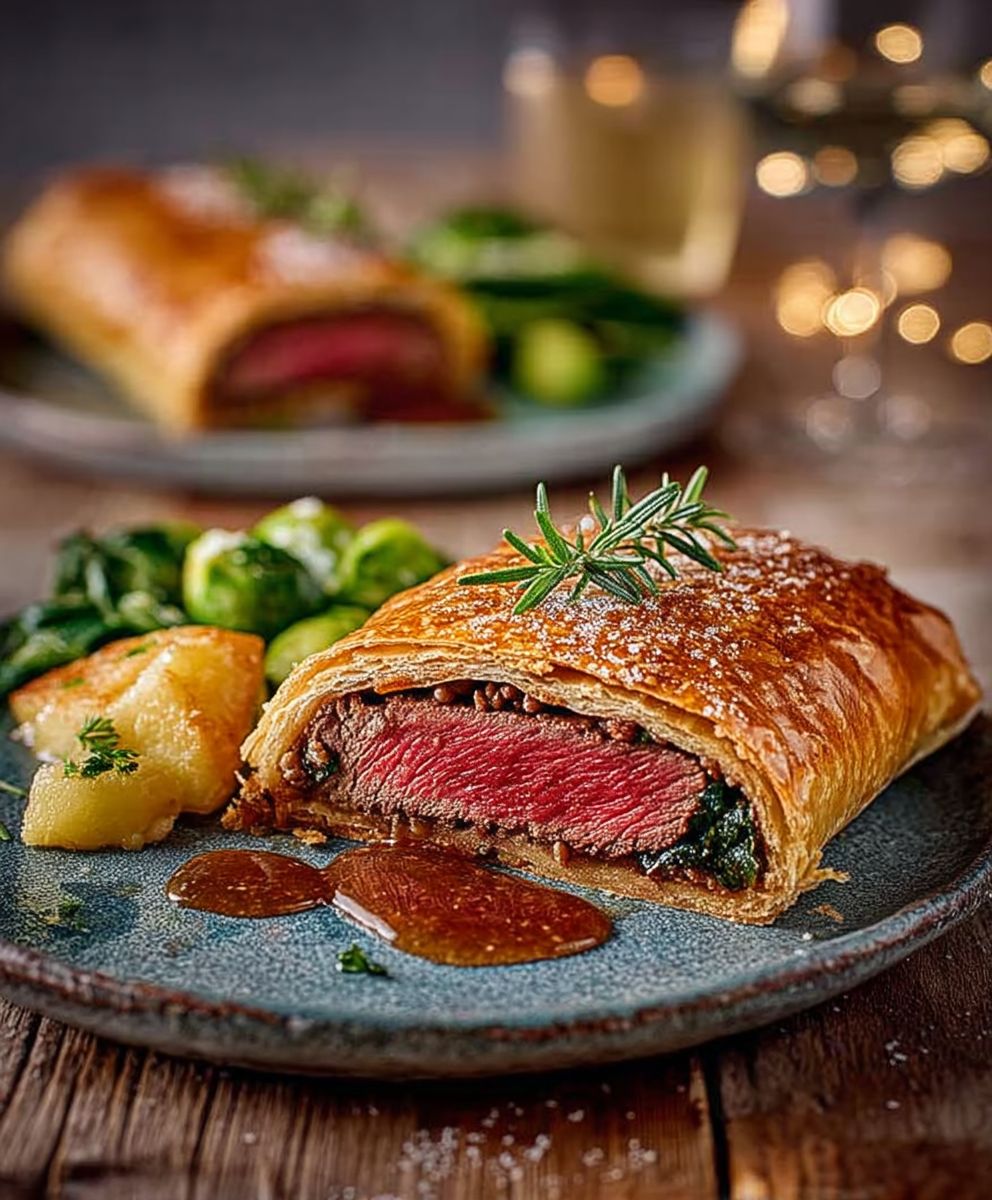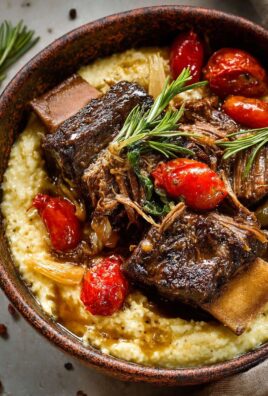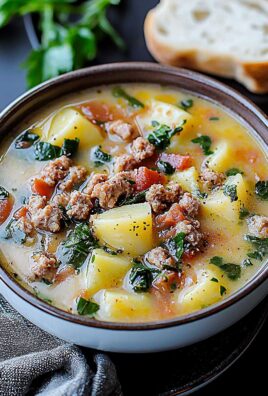Beef Wellington. Just the name conjures images of elegant dinner parties and culinary masterpieces, doesn’t it? But don’t let its reputation intimidate you! I’m here to show you that creating this show-stopping dish at home is entirely achievable, and the reward is absolutely worth the effort. Imagine slicing into a perfectly golden, flaky pastry to reveal a tender, rosy-pink beef tenderloin, enveloped in a savory duxelles and salty prosciutto.
The history of Beef Wellington is a bit murky, with some claiming it was created to honor the Duke of Wellington after his victory at Waterloo. Others believe it’s a variation of the French filet de boeuf en croûte. Regardless of its true origins, this dish has become synonymous with special occasions and fine dining.
So, why is Beef Wellington so beloved? It’s a symphony of textures and flavors! The crisp, buttery puff pastry gives way to the earthy, umami-rich mushroom duxelles, followed by the salty, delicate prosciutto, and finally, the melt-in-your-mouth beef tenderloin. It’s an experience for the senses, and a guaranteed way to impress your guests (or simply treat yourself!). Let’s embark on this culinary adventure together, and I’ll guide you through each step to create a Beef Wellington that will have everyone singing your praises.
Ingredients:
- For the Beef:
- 2.5-3 lb center-cut beef tenderloin roast, trimmed of silver skin
- 2 tablespoons olive oil
- Salt and freshly ground black pepper, to taste
- For the Duxelles:
- 1 tablespoon olive oil
- 1 shallot, finely chopped
- 1 lb cremini mushrooms, finely chopped
- 2 cloves garlic, minced
- 1/4 cup dry sherry
- 2 tablespoons fresh thyme leaves
- 2 tablespoons unsalted butter
- Salt and freshly ground black pepper, to taste
- For the Pâté:
- 4 oz smooth chicken liver pâté (or duck liver pâté)
- For the Crêpes (optional, but recommended):
- 1 cup all-purpose flour
- 1 1/4 cups milk
- 2 large eggs
- 2 tablespoons melted unsalted butter
- 1/4 teaspoon salt
- For the Puff Pastry:
- 2 sheets (14.1 oz each) frozen puff pastry, thawed
- For the Egg Wash:
- 1 large egg, beaten
- Optional Garnishes:
- Fresh thyme sprigs
- Coarse sea salt
Preparing the Beef Tenderloin:
- Sear the Beef: Pat the beef tenderloin dry with paper towels. Season generously with salt and freshly ground black pepper. Heat olive oil in a large, oven-safe skillet (cast iron is ideal) over high heat. Sear the beef on all sides until deeply browned, about 2-3 minutes per side. This step is crucial for developing flavor and creating a beautiful crust. Don’t overcrowd the pan; sear in batches if necessary.
- Cool the Beef: Remove the seared beef from the skillet and place it on a wire rack set over a baking sheet. Allow it to cool completely. This is important because you don’t want to trap heat inside the Wellington, which can lead to uneven cooking.
Making the Duxelles:
- Sauté the Shallot: Heat olive oil in a large skillet over medium heat. Add the finely chopped shallot and cook until softened and translucent, about 3-5 minutes. Be careful not to brown the shallot.
- Cook the Mushrooms: Add the finely chopped cremini mushrooms to the skillet. Cook, stirring occasionally, until the mushrooms release their liquid and the liquid evaporates, about 10-15 minutes. It’s important to cook the mushrooms until they are quite dry, as excess moisture can make the puff pastry soggy.
- Add Garlic, Sherry, and Thyme: Add the minced garlic, dry sherry, and fresh thyme leaves to the skillet. Cook for another 2-3 minutes, stirring constantly, until the sherry has evaporated and the garlic is fragrant.
- Finish with Butter: Stir in the unsalted butter until melted and incorporated. Season with salt and freshly ground black pepper to taste.
- Cool the Duxelles: Remove the duxelles from the heat and allow it to cool completely. Again, cooling is essential to prevent the puff pastry from becoming soggy. You can even refrigerate the duxelles for a faster cooling process.
Making the Crêpes (Optional):
While the crêpes are optional, they add a layer of protection between the duxelles and the puff pastry, helping to prevent sogginess. If you choose to skip this step, you can proceed directly to spreading the pâté on the beef.
- Combine Ingredients: In a blender, combine the all-purpose flour, milk, eggs, melted unsalted butter, and salt. Blend until smooth.
- Rest the Batter: Let the batter rest for at least 30 minutes at room temperature. This allows the gluten to relax, resulting in more tender crêpes.
- Cook the Crêpes: Heat a lightly oiled crêpe pan or non-stick skillet over medium heat. Pour about 1/4 cup of batter onto the hot pan, swirling to coat the bottom evenly. Cook for 1-2 minutes per side, or until lightly golden brown.
- Stack the Crêpes: Stack the cooked crêpes on a plate, covering them with plastic wrap to keep them moist. You’ll need enough crêpes to completely wrap the beef tenderloin.
Assembling the Beef Wellington:
- Spread the Pâté: Spread the smooth chicken liver pâté evenly over the cooled beef tenderloin. This adds richness and flavor to the Wellington.
- Wrap with Crêpes (Optional): If using crêpes, lay them out on a clean work surface, overlapping them slightly to create a large sheet. Place the pâté-covered beef tenderloin in the center of the crêpes and wrap tightly, sealing the edges with a little bit of water if needed.
- Wrap with Duxelles: Spread the cooled duxelles evenly over the crêpe-wrapped (or pâté-covered) beef tenderloin, completely covering the surface.
- Wrap with Puff Pastry: On a lightly floured surface, roll out one sheet of puff pastry to a size large enough to completely enclose the beef tenderloin. Repeat with the second sheet of puff pastry.
- Enclose the Beef: Place the duxelles-covered beef tenderloin in the center of one sheet of puff pastry. Brush the edges of the pastry with egg wash. Carefully wrap the pastry around the beef, sealing the edges tightly. Trim any excess pastry.
- Decorate (Optional): Use the trimmed pastry scraps to create decorative shapes, such as leaves or flowers. Attach the decorations to the top of the Wellington with egg wash.
- Chill the Wellington: Wrap the assembled Beef Wellington tightly in plastic wrap and refrigerate for at least 30 minutes, or up to 24 hours. This helps the pastry to relax and prevents it from shrinking during baking.
Baking the Beef Wellington:
- Preheat the Oven: Preheat your oven to 400°F (200°C).
- Egg Wash: Brush the entire surface of the Beef Wellington with egg wash. This will give it a beautiful golden-brown color.
- Score the Pastry: Use a sharp knife to score the top of the pastry in a decorative pattern. This allows steam to escape during baking and prevents the pastry from puffing up unevenly.
- Bake: Place the Beef Wellington on a baking sheet lined with parchment paper. Bake for 30-40 minutes, or until the pastry is golden brown and the internal temperature of the beef reaches 125-130°F (52-54°C) for medium-rare, 130-135°F (54-57°C) for medium, or 135-140°F (57-60°C) for medium-well. Use a meat thermometer to ensure accurate temperature readings.
- Rest: Remove the Beef Wellington from the oven and let it rest for at least 10-15 minutes before slicing. This allows the juices to redistribute, resulting in a more tender and flavorful dish.
Serving the Beef Wellington:
- Slice: Use a sharp serrated knife to slice the Beef Wellington into 1-inch thick slices.
- Garnish (Optional): Garnish with fresh thyme sprigs and a sprinkle of coarse sea salt.
- Serve: Serve immediately and enjoy! This dish is best served with a rich red wine.

Conclusion:
And there you have it! I truly believe this Beef Wellington recipe is a must-try, a culinary adventure that will impress your guests and leave you feeling like a true chef. It might seem intimidating at first glance, but breaking it down into manageable steps makes it surprisingly achievable, and the end result is undeniably worth the effort. The combination of the perfectly seared beef tenderloin, the savory duxelles, the flaky puff pastry, and that rich, decadent flavor profile is simply divine. It’s a symphony of textures and tastes that will tantalize your taste buds and leave you wanting more.
But why is this Beef Wellington so special? It’s more than just a dish; it’s an experience. It’s the satisfaction of creating something truly impressive from scratch. It’s the joy of sharing a memorable meal with loved ones. It’s the feeling of accomplishment that comes with mastering a classic recipe. And, of course, it’s the sheer deliciousness of every single bite.
Now, let’s talk about serving suggestions and variations to make this Beef Wellington your own. For a classic presentation, slice the Wellington into thick medallions and serve with a rich red wine reduction sauce. A simple side of roasted asparagus or creamy mashed potatoes complements the dish beautifully. If you’re feeling adventurous, you could try adding a layer of prosciutto between the duxelles and the pastry for an extra layer of flavor. Or, for a vegetarian twist, substitute the beef tenderloin with a large portobello mushroom cap, marinated in balsamic vinegar and herbs.
Another variation I’ve experimented with is adding a touch of truffle oil to the duxelles for an even more luxurious flavor. Just a few drops will elevate the earthy notes of the mushrooms and create a truly unforgettable experience. You could also try using different types of mushrooms in the duxelles, such as shiitake or oyster mushrooms, to add a unique twist.
Don’t be afraid to experiment and make this recipe your own! The key is to have fun and enjoy the process. Remember to take your time, follow the instructions carefully, and don’t be afraid to ask for help if you need it. Cooking should be a joyful experience, and this Beef Wellington recipe is no exception.
I’m so excited for you to try this recipe and experience the magic of Beef Wellington for yourself. I know you’ll be amazed by the results. And most importantly, I want to hear all about your experience! Did you make any variations? What did your guests think? What was your favorite part of the process?
Please, don’t hesitate to share your photos, comments, and feedback in the comments section below. I love hearing from you and seeing your culinary creations. Your experiences inspire me and help me to continue creating delicious and accessible recipes for everyone to enjoy. So go ahead, give this Beef Wellington recipe a try, and let me know what you think. Happy cooking! I am confident that you will find that this Beef Wellington is worth the effort.
Beef Wellington: The Ultimate Guide to a Perfect Dish
Seared beef tenderloin wrapped in pâté, savory mushroom duxelles, optional crêpes, and flaky puff pastry. A show-stopping centerpiece.
Ingredients
- 2.5-3 lb center-cut beef tenderloin roast, trimmed of silver skin
- 2 tablespoons olive oil
- Salt and freshly ground black pepper, to taste
- 1 tablespoon olive oil
- 1 shallot, finely chopped
- 1 lb cremini mushrooms, finely chopped
- 2 cloves garlic, minced
- 1/4 cup dry sherry
- 2 tablespoons fresh thyme leaves
- 2 tablespoons unsalted butter
- Salt and freshly ground black pepper, to taste
- 4 oz smooth chicken liver pâté (or duck liver pâté)
- 1 cup all-purpose flour
- 1 1/4 cups milk
- 2 large eggs
- 2 tablespoons melted unsalted butter
- 1/4 teaspoon salt
- 2 sheets (14.1 oz each) frozen puff pastry, thawed
- 1 large egg, beaten
- Fresh thyme sprigs
- Coarse sea salt
Instructions
- Pat the beef tenderloin dry with paper towels. Season generously with salt and freshly ground black pepper. Heat olive oil in a large, oven-safe skillet (cast iron is ideal) over high heat. Sear the beef on all sides until deeply browned, about 2-3 minutes per side. Remove from skillet and place on a wire rack set over a baking sheet. Allow to cool completely.
- Heat olive oil in a large skillet over medium heat. Add the finely chopped shallot and cook until softened and translucent, about 3-5 minutes. Add the finely chopped cremini mushrooms to the skillet. Cook, stirring occasionally, until the mushrooms release their liquid and the liquid evaporates, about 10-15 minutes. Add the minced garlic, dry sherry, and fresh thyme leaves to the skillet. Cook for another 2-3 minutes, stirring constantly, until the sherry has evaporated and the garlic is fragrant. Stir in the unsalted butter until melted and incorporated. Season with salt and freshly ground black pepper to taste. Remove from the heat and allow it to cool completely.
- In a blender, combine the all-purpose flour, milk, eggs, melted unsalted butter, and salt. Blend until smooth. Let the batter rest for at least 30 minutes at room temperature. Heat a lightly oiled crêpe pan or non-stick skillet over medium heat. Pour about 1/4 cup of batter onto the hot pan, swirling to coat the bottom evenly. Cook for 1-2 minutes per side, or until lightly golden brown. Stack the cooked crêpes on a plate, covering them with plastic wrap to keep them moist.
- Spread the smooth chicken liver pâté evenly over the cooled beef tenderloin. If using crêpes, lay them out on a clean work surface, overlapping them slightly to create a large sheet. Place the pâté-covered beef tenderloin in the center of the crêpes and wrap tightly, sealing the edges with a little bit of water if needed. Spread the cooled duxelles evenly over the crêpe-wrapped (or pâté-covered) beef tenderloin, completely covering the surface.
- On a lightly floured surface, roll out one sheet of puff pastry to a size large enough to completely enclose the beef tenderloin. Repeat with the second sheet of puff pastry. Place the duxelles-covered beef tenderloin in the center of one sheet of puff pastry. Brush the edges of the pastry with egg wash. Carefully wrap the pastry around the beef, sealing the edges tightly. Trim any excess pastry.
- Use the trimmed pastry scraps to create decorative shapes, such as leaves or flowers. Attach the decorations to the top of the Wellington with egg wash. Wrap the assembled Beef Wellington tightly in plastic wrap and refrigerate for at least 30 minutes, or up to 24 hours.
- Preheat your oven to 400°F (200°C). Brush the entire surface of the Beef Wellington with egg wash. Use a sharp knife to score the top of the pastry in a decorative pattern. Place the Beef Wellington on a baking sheet lined with parchment paper. Bake for 30-40 minutes, or until the pastry is golden brown and the internal temperature of the beef reaches 125-130°F (52-54°C) for medium-rare, 130-135°F (54-57°C) for medium, or 135-140°F (57-60°C) for medium-well.
- Remove the Beef Wellington from the oven and let it rest for at least 10-15 minutes before slicing.
- Use a sharp serrated knife to slice the Beef Wellington into 1-inch thick slices. Garnish with fresh thyme sprigs and a sprinkle of coarse sea salt. Serve immediately.
Notes
- Cooling the beef and duxelles completely is crucial to prevent soggy puff pastry.
- The crêpes are optional but highly recommended as they provide an extra layer of protection against moisture.
- Use a meat thermometer to ensure the beef is cooked to your desired doneness.
- Resting the Wellington after baking allows the juices to redistribute, resulting in a more tender and flavorful dish.





Leave a Comment